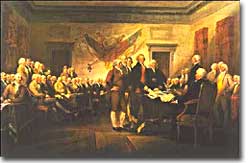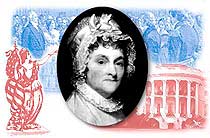
10. E Pluribus Unum

Artist John Trumbull's Declaration of Independence memorializes individuals who were engaged in the process of declaring independence rather than an actual event. Not all of those pictured were present at the reporting of the Declaration on June 28, nor were they all at its adoption on July 4, 1776.
The unanimous Declaration of Independence was a curious outcome. Remember the failed Albany Plan of Union in 1754. Benjamin Franklin's political cartoon appeal — "Join, or Die" fell on deaf colonial ears. In 1763, it was difficult to get the original thirteen to agree on the time of day. This "coming together" will happen very gradually. We have examined the events and people that propelled the colonies to revolt. A careful examination of the stages of unity is in order.
The Declaration of Independence was a product of the Second Continental Congress. Two earlier intercolonial conferences had occurred, each building important keystones of colonial unity. The Stamp Act Congress and the First Continental Congress brought the delegates from differing colonies to agreement on a message to send to the king. Each successive Congress brought greater participation. Each time the representatives met, they were more accustomed to compromise. As times grew more desperate, the people at home became more and more willing to trust their national leaders.
Organizations were also formed to meet intercolonial objectives. The Long Room Club, of which James Otis, Samuel Adams, John Hancock, and Paul Revere were members, was one of the earliest known organizations formed in reaction to British measures. The Association actively promoted nonimportation beyond Massachusetts. The Sons and Daughters of Liberty proved to be the most effective. The Sons of Liberty represented the radical wing of patriots through the years of crisis. They would not hesitate to scare a customs official out of town or tar and feather an enemy. Although strongest in Boston, the Sons of Liberty were active in many port cities, reaching as far South as Charleston.

"I wish you would remember the ladies and be more generous and favourable to them than your ancestors. Do not push such unlimited power in the hands of husbands." -Abigail Adams in a March 1776 letter to her husband
The Daughters of Liberty performed an equally important function. If nonimportation were to succeed, women must be involved. The Daughters of Liberty ensured that women did not purchase British goods. In addition, if British cloth was not imported, more homespun cloth must be made. The Daughters of Liberty advanced this cause most effectively.
No unity could be reached without communication. Great literature was produced throughout these critical years. Patrick Henry's Virginia Resolves and John Dickinson's famous circular letter are two such examples that were widely read in each of the colonies. Samuel Adams organized the first committee of correspondence to circulate the important arguments of the day. Thomas Paine's Common Sense sold 120,000 copies in the first three months of publication. Even the Declaration of Independence served not only to send a message to King George, but to convince many American colonists of the glory of their cause.





